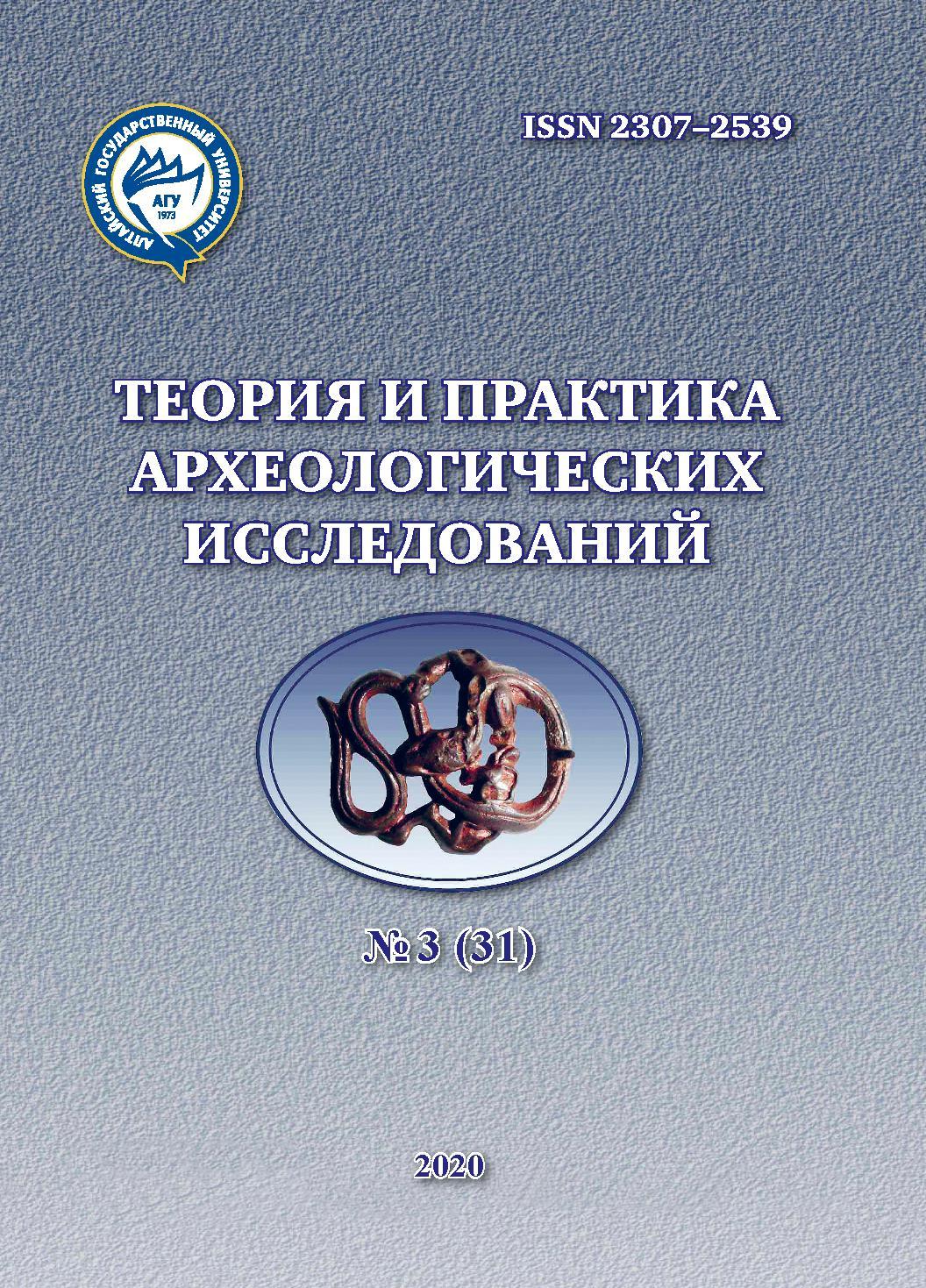THE FORESHORTENING IN THE POETICS OF THE PALEOMETAL AGE IN THE NORTH CAUCASUS
Abstract
The article is devoted to the consideration of specific features of constructing images of the Maikop and Novosvoboda cultures of the North Caucasus. The visible originality of the images on the vessels from the Oshad mound, the vessel from the Sunzhensk burial ground, the slabs from the burial in the Kladi tract,the presence of small sculptural forms allows us to get to the basics of the poetics of fine art in the North Caucasus of the early Metal Age. The article deals with one of the aspects of poetics related to the originality of the foreshortening in the depiction of the Maikop and Novosvoboda cultures. The peculiarity lies in the use of techniques of reverse perspective, a special point of view (the point from which images are built on the plane) in paintings, combination the front and profile presentation of images within the picture, summing up the overall impression from such different foreshortening. The specificity of plastic art forms of North Caucasian cultures is noted. All of these features of depiction allow us to speak about a fairly high degree of mythologization of the consciousness the Maykop and Novosvoboda cultures representatives. The revealed pictorial techniques are universal for the cultures of a certain historical stage of development of society, and therefore observations of North Caucasian figurativeness allow them to be transferred to the figurativeness of other cultures of Northern Eurasia during the early metal and Bronze Ages.
Downloads
Metrics
References
Zhegin L.F. Yazyk zhivopisnogo proizvedeniya (Uslovnost’ drevnego iskusstva) [The Language of Painting (Convention of Ancient Art)]. M. : Iskusstvo, 1970. 236 p.
Kovtun I.V. Izobrazitelnye kompozicii sejminsko-turbinskih kinzhalov [Figurative Compositions of the Seima-Turbino Daggers]. Teoriya i praktika arheologicheskih issledovanij. Vyp. 4 [Theory and Ppractice of Archaeological Research. Issue 4]. Barnaul : Izd-vo Alt. un-ta, 2008. Pp. 18–30.
Korenevskij S.N. Zoomorfnyye i antropomorfnye obrazy v iskusstve plem’on majkopsko-novosvobodnenskoj obshchnosti [Zoomorphic and Anthropomorphic Images in the Art of the Tribes of the Maikop-Novosvobodnaya Community]. Mirovozzrenie drevnego naseleniya Evraziii [Worldview of the Ancient Population of Eurasia]. M. : Staryj Sad, 2001. Pp. 45–59.
Korol’kova E.F. Teoreticheskie problemy iskusstvoznaniya i «zverinyj stil’» skifskoj epohi. K formirovaniyu glossariya osnovnyh terminov i ponyatij [Theoretical Problems of Art History and the“Animal Style” of the Scythian Era. To the Formation of a Glossary of Basic Terms and Concepts]. SPb. : [B.i.], 1996. 78 p.
Kuzin-Losev V.I. Kompozicionnye osnovy drevnego izobrazitel’nogo iskusstva stepnoj Evrazii. Ch. 1 [Compositional Foundations of the Ancient Fine Art of the Eurasian Steppe. Part 1]. Arheologicheskij al’manah [Archaeological Almanac]. № 21. 2010. Pp. 35–77.
Kuzin-Losev V.I. Struktura izobrazitel’nogo teksta vtorogo serebryanogo sosuda iz majkopskogo kurgana Oshad [The Structure of the Pictorial Text of the Second Silver Vessel from the Maikop Mound Oshad]. Kul’tury stepnoj Evrazii i ih vzaimodejstvie s drevnimi civilizaciyami. Kn. 1 [The Cultures of Steppe Eurasia and Their Interaction with Ancient Civilizations. Book. 1]. SPb. : Periferiya, 2012. Pp. 200–205.
Piotrovskij Yu.Yu. Zametki o sosudah s izobrazheniyami iz Majkopskogo kurgana (Oshad) [Notes on the Vessels with Images from the Maikop Mound (Oshad)].Pamyatniki drevnego i srednevekovogo iskusstva: Problemy arheologii [The Sites of Ancient and Medieval Art: Problems of Archaeology]. SPb. : SPbGU, 1994. Pp. 85–92.
Rezepkin A.D. K interpretacii rospisi iz grobnicy majkopskoj kul’tury bliz stanicy Novosvobodnaya [On the Interpretation of the Painting from the Tomb of the Maikop Culture near the Village of Novosvobodnaya]. KSIA AN SSSR. Issue 192. M. : Nauka, 1987. Pp. 26–33.
Rezepkin A.D. Kurgan 31 mogil’nika Klady. Problemy genezisa i hronologii majkopskoj kul’tury [Kurgan 31 of the Klada Burial Ground. Problems of the Genesis and Chronology of the Maikop Culture]. Drevnie kul’tury Prikuban’ya (po materialam rabot v zonah melioracii Krasnodarskogo kraya) [Ancient Cultures of the Kuban Region (based on materials of work in the zones of reclamation of the Krasnodar Territory)]. L. : Nauka, 1991. Pp. 167–197.
Rezepkin A.D. Novosvobodnenskaya kul’tura (na osnove materialov mogil’nika «Klady») [Novosvobodnenskaya Culture (based on the Materials from the Klady Burial Ground)]. SPb. : Nestor-Istoriya, 2012. 344 p.
Savostina E.A. Fronton arhaicheskogo hrama: obraz universuma – Meduza Gorgona [Pediment of an Archaic Temple: the Image of the Universe – Medusa the Gorgon]. Obraz-smysl v antichnoj kul’ture [the Image-Meaning in the Ancient Culture]. M. : GMII im. A.S. Pushkina, 1990. Pp. 134–150.
Sovetova O.S., Ladygina Yu.M. Sceny s zhenskimi personazhami v naskal’nom iskusstve Sayano-Altaya [Scenes with Female Characters in the Rock Art of Sayano-Altai]. Kul’tury i narody Severnoj i Central’noj Azii v kontekste mezhdisciplinarnogo izucheniya. Vyp. 3 [Cultures and Peoples of North and Central Asia in the Context of Interdisciplinary Study. Issue 3]. Tomsk : TGU, 2013. Pp. 291–304.
Uspenskij B.A. K issledovaniyu yazyka drevnej zhivopisi [To the Study of the Language of Ancient Painting]. Zhegin L.F. Yazyk zhivopisnogo proizvedeniya (Uslovnost’ drevnego iskusstva) [Zhegin L.F. The Language of Painting (Convention of Ancient Art)]. M., 1970b. 314 p.
Uspenskij B.A. K sisteme peredachi izobrazheniya v russkoj ikonopisi [Uspensky B.A. To the System of Image Transmission in Russian Icon Painting]. Trudy po znakovym sistemam. T. II [Proceedings on Sign Systems. Vol. II]. Tartu, 1965. Pp. 248–257 (Uchenye zapiski TGU, vyp. 181) [(Scientific Notes of TSU, Issue 181)].
Uspenskij B.A. Poetika kompozicii. Struktura hudozhestvennogo teksta i tipologiya kompozicionnoj formy [Poetics of Composition: the Structure of Literary Text and Typology of Compositional Form]. M.: Iskusstvo, 1970a. 256 p.
Uspenskij B.A. Semiotika ikony [Semiotics of Icons]. Semiotika iskusstva [Semiotics of Art]. M.: Shkola «Yazyki russkoj kul’tury», 1995. Pp. 221–303.
Farmakovskij B.V. Arhaicheskij period v Rossii [Archaic Period in Russia]. MAR. №34. SPb., 1914. Pp. 50–76.
Florenskij P.A. Obratnaya perspektiva [Reverse Perspective]. Trudy po znakovym sistemam. T. III [Proceedings on Sign Systems. Vol. III]. Tartu, 1967. Pp. 381–416 (Uchenye zapiski TGU, vyp. 198) [(Scientific Notes of TSU, Issue 198)].
Formozov A.A. Pamyatniki pervobytnogo iskusstva na territorii SSSR [The Sites of Primitive Art on the Territory of the USSR]. M. : Nauka, 1966. 128 p.
Fursikova E.G. O stilisticheskih parallelyah v okunyovskom i skifo-sibirskom iskusstve [On Stylistic Parallels in the Okunevo and Scythian-Siberian Art]. Stepi Evrazii v drevnosti i srednevekov’e. Kn. 1 [The Steppes of Eurasia in Antiquity and the Middle Ages. Boo. 1]. SPb. : Izd-vo Gos. Ermitazha, 2002. Pp. 247–250.
Theory and Practice of Archaeological Research is a golden publisher, as we allow self-archiving, but most importantly we are fully transparent about your rights.
Authors may present and discuss their findings ahead of publication: at biological or scientific conferences, on preprint servers, in public databases, and in blogs, wikis, tweets, and other informal communication channels.
Theory and Practice of Archaeological Research allows authors to deposit manuscripts (currently under review or those for intended submission to ABS) in non-commercial, pre-print servers such as ArXiv.
Authors who publish with this journal agree to the following terms:
- Authors retain copyright and grant the journal right of first publication with the work simultaneously licensed under a Creative Commons Attribution License (CC BY 4.0) that allows others to share the work with an acknowledgement of the work's authorship and initial publication in this journal.
- Authors are able to enter into separate, additional contractual arrangements for the non-exclusive distribution of the journal's published version of the work (e.g., post it to an institutional repository or publish it in a book), with an acknowledgement of its initial publication in this journal.
- Authors are permitted and encouraged to post their work online (e.g., in institutional repositories or on their website) prior to and during the submission process, as it can lead to productive exchanges, as well as earlier and greater citation of published work (See The Effect of Open Access).








2.jpg)



